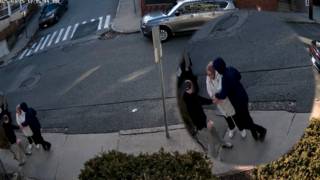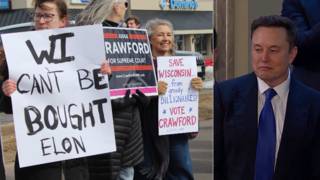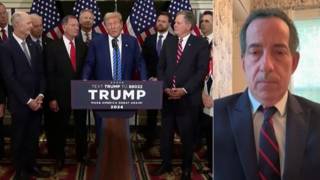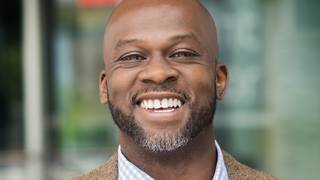
Topics
Guests
- James RidgewaySenior Washington correspondent for Mother Jones magazine. His latest article is called “There’s Something About Mary: Unmasking a Gun Lobby Mole.”
- Barbara HohltExecutive Director of States United to Prevent Gun Violence.
Mother Jones magazine has revealed a well-known activist in the gun control movement is actually a secret spy for the National Rifle Association and the gun lobby. Over the past decade, the woman, Mary Lou Sapone, managed to become active in almost every single major gun violence prevention organization. Sapone, who went by her maiden name Mary McFate, helped organize the Million Mom March in 2000 and oversaw the lobbying efforts of States United to Prevent Gun Violence. We speak with investigative journalist James Ridgeway, who helped break the story, and Barbara Hohlt of States United to Prevent Gun Violence, who knew and worked with Sapone. [includes rush transcript]
Transcript
AMY GOODMAN: We move now to another explosive story, this about the infiltration of gun control groups by a secret spy for the National Rifle Association.
For more than a decade Mary McFate was a prominent gun control activist involved in almost every single national gun control organization. She served on their boards, attended strategy meetings, organized the Million Mom March in 2000, lobbied Washington to prevent gun violence.
Mary Lou Sapone was a freelance spy who worked for the National Rifle Association. She covertly infiltrated gun control groups, as well as environmental and animal rights groups, while working as an operative for private security firms hired by corporations.
A Mother Jones investigation revealed last week that Mary McFate and Mary Lou Sapone are the same person. The article is called “There’s Something About Mary: Unmasking a Gun Lobby Mole.”
The revelations about Mary McFate’s double life have shocked the gun control community, who trusted her for years.
I’m joined now here in the firehouse studio by Barbara Hohlt, the executive director of States United to Prevent Gun Violence. James Ridgeway is senior Washington correspondent for Mother Jones magazine. He has been investigating the spying activities of Mary Lou Sapone for months and helped break this story. He joins us from Washington, D.C.
Welcome, both, to Democracy Now!
Jim Ridgeway, how did you hear about this? How did you unmask this mole?
JAMES RIDGEWAY: Well, I had a tip, basically. And the way I did it was I had done previous stories about a company called BBI, and that was an investigations company down in Easton, Maryland. And one of the investor in BBI came to the conclusion that he was being defrauded. So he went into BBI, and he took out all the records, and he put them in a storehouse. And these records then revealed the internal workings of this organization, of this detective company.
So, what I did was, since I knew that Mary Lou Sapone had been involved in an environmental case working for BBI in Louisiana, I went down, and I started looking for — inside the ledgers of this BBI for the NRA, to see if they were a client. And it turned out they were a client.
So then the question was, did this have anything to do with Mary Lou Sapone? And so, I remembered there was a suit brought by the owner of this company, the guy that thought he was defrauded, and so I asked him to go through a couple of depositions by key people in BBI in this suit and see whether there was any reference to Mary Lou Sapone. And sure enough, he found the reference.
And the reference basically — there were several references. And in one case, it was clear that, of course, Mary Lou Sapone worked for BBI. In another case, it was — in another section, it was clear that Mary Lou Sapone was a subcontractor or associated with the NRA. And then it was made clear that Mary Lou Sapone actually introduced the NRA to BBI. So, I thought that was pretty interesting.
So then, my colleagues, David Corn and Dan Schulman, and I, we continued to work on this, and we started talking to the gun groups. And we put two and two together. And finally, David Corn, in a rash move, picked up the telephone — we had found that the numbers of Mary Lou Sapone and Mary McFate were the same. So we called the number in Sarasota, Florida. A woman answered. And he said, “Is this Mary Lou Sapone?” The woman said yes. And he said, “Well, this is David Corn from Mother Jones magazine.” Bang! That was it. And so, we proceeded from there.
AMY GOODMAN: We’re also joined by Barbara Hohlt, executive director of States United to Prevent Gun Violence. Mary was your lobbyist.
BARBARA HOHLT: Yes, not immediately. I first met Mary — I was trying to remember — a number of years ago back in the movement, and she was always very active, and she was active in almost every single organization. And in 2005 — it’s funny — I volunteered to be the executive director of States United to Prevent Gun Violence, because this is like a trade association of all the state organizations around the country that work on gun violence prevention, and they’re all very small groups, and so their trade association doesn’t have much money, but is still working hard on this issue. And Mary was there as a sort of an alternate representative from a couple of the states, and she was very involved and very interested in everything that was going on.
She also frequently went to Washington, because she was active in the Million Moms. She, on her own, would go and visit members of Congress about the various issues around gun violence prevention. And one day, we were talking, and we said, “Well, you know, maybe if you’re going all the time to Congress, you would like to represent — to go for some of our states that don’t have the money or time to send somebody to D.C.” And she said she’d be interested in doing that. So, in 2006 — I just looked it up — in the summer, we took a board vote authorizing her to lobby for those state organizations that wanted her as their lobbyist. They had to agree to it. They had to talk to her about it. And so, at that point, she did start doing some lobbying for us.
AMY GOODMAN: And she was known to you as Mary McFate.
BARBARA HOHLT: She was known to us as Mary McFate.
AMY GOODMAN: Her maiden name.
BARBARA HOHLT: Yeah, yeah. I think that the thing that’s really gotten everybody about this is we — many of our groups have victims of gun violence in them. In some cases, the executive director of the group is a victim of gun violence. And they’ve all known Mary for a long time, and they’ve told her their stories and shared their experiences and pain with her. And so, particularly to victims of gun violence, this is very devastating to have this happen, to find out that this person that you thought you were talking to and was working with you is reportedly working for the other side. It’s a very — it’s not like finding out that somebody is spying on a corporation; it’s finding out that somebody is spying on victims of gun violence. So it’s kind of like a double victimization almost.
AMY GOODMAN: Her level of involvement with not one, not two, but many of the groups, almost all of them, the leading groups against gun violence, we’ll talk about after break. Our guests are Barbara Hohlt, executive director of States United to Prevent Gun Violence — Mary McFate was their lobbyist in Washington — and James Ridgeway, who exposed this story with David Corn in the Mother Jones magazine. Stay with us.
[break]
AMY GOODMAN: Our guests are Barbara Hohlt, executive director of States United to Prevent Gun Violence — Mary McFate was their lobbyist in Washington — it’s a well-known anti-gun group, a coalition of the different anti-gun violence groups; and Jim Ridgeway, senior Washington correspondent for Mother Jones magazine.
Jim Ridgeway, explain the number of groups that Mary McFate — her real name, Mary Lou Sapone — worked her way through over this last decade.
JAMES RIDGEWAY: Well, as you’ve just heard, I mean, there was a whole network of groups, state groups, and then there was the Brady campaign, which is pretty well known in Washington. And originally, I found out that Mary — I mean, I sort of confirmed that Mary McFate was into this by looking up a group called CeaseFire in Pennsylvania. Mary McFate, when she was Mary Lou Sapone, was running this Louisiana operation out of Pennsylvania. So there’s — actually, it’s probably unknown how many groups she was involved with, but, I mean, we talked to a good number of people, and her visibility was pretty widespread.
But let me just point out also that in one of her emails that I discovered, she said that this was kind of like a family operation, that her overall business was like a family operation. And she had a son named Sean, who was a military person who’s pretty well known, and that he was part of it, and that a daughter-in-law named Montgomery McFate, who was a well-known anthropologist, was also there. And we found a bill from a company run by Mary Lou McFate called Strategic Solutions to BBI — that’s the detective company — from Montgomery McFate, and we were told, and records proved, that Montgomery McFate also worked as a staff member of Handgun Inc. So, neither Montgomery McFate nor Sean McFate would talk to us, but there is the whole question of her family, of her immediate family.
AMY GOODMAN: Barbara Hohlt, the involvement in the different groups and also your experience once with, on the one hand, you thought she was extremely well off, would talk about, when she dropped out of sight, being on cruises, and on the other hand, well, wanting to save money on a phone call?
BARBARA HOHLT: Right, OK. Well, I think nobody ever doubted, as time went on, Mary’s dedication to the cause, because she was involved in so many things. In some ways, she was like me. I’m a volunteer, too. I’m lucky to have the time to do this.
But she was involved in practically every group. She started out with the Pennsylvanians Against Handgun Violence, which is now a group that no longer exists that was in Pittsburgh. Apparently she lived in Grove City, Pennsylvania and got involved with that group. Then, she got involved with the Million Mom March in 2000. People from the Million Mom March — she got involved in CeaseFire PA, which was a new group formed in Pennsylvania after the march by some of the moms from Pennsylvania. Through her state group, she was involved in States United to Prevent Gun Violence. Then, recently, she also was involved with Freedom States Alliance, which is another coalition of state groups that was formed in the Midwest, and she’s actually a board member of both Freedom States Alliance and CeaseFire PA — was a board member.
And she was a person who, like, had the ability to go everywhere. She went to all kinds of conferences. She always went to the NRA conference. She went to any demonstrations people were putting on, no matter where they were. So she was really widely traveled.
About three weeks ago, I was with her at the small arms conference at the UN. She is a member of IANSA, which is the International Action Network against Small Arms. So she was really involved in the complete picture. And sometimes afterwards — you know, we didn’t think about it — we thought of her as really a dedicated volunteer, and I think people have been very upset by that, because they think that they were talking to someone, and now they’re realizing maybe they were talking to someone who was being dishonest with them the whole time.
AMY GOODMAN: Looking back, the odd encounters, like her dropping in at New Yorkers Against Gun Violence?
BARBARA HOHLT: Well, actually, we realized the other day, the oddest encounter with New Yorkers Against Gun Violence, was not asking to come and use the telephone; about a year and a half ago, she came to the annual meeting of New Yorkers Against Gun Violence. Now, we’re not a large group; we’re a small, you know, advocacy group, and we have an annual meeting once a year. And Mary is not from New York, so it was sort of a surprise, but she said she was up here — I think she said she was in New York because she was going to go to plays. And when we talked about that meeting, we realized that the speaker at the meeting was somebody from the Law Department of the City of New York, and he was speaking about the cases against the gun dealers down in the South. So it was funny that she should turn up for that particular meeting.
AMY GOODMAN: You also have a side interesting story, Jim Ridgeway, in your piece, “Something About Mary,” about her daughter and son-in-law, Sean and Montgomery Sapone, “better known as Sean and Montgomery McFate, a successful Washington couple,” you write, “whose current bios make no mention of any past intelligence-gathering or opposition-research work. Sean [is] currently the program director of the national security initiative at the Bipartisan Policy Center.” You say that Montgomery “made a name for herself as one of the primary architects of the US military’s human terrain program, which teams social scientists with military units in Iraq and Afghanistan to help soldiers better understand the local culture” — very controversial in the American Anthropological Association.
JAMES RIDGEWAY: Well, yes. Ms. McFate has — you know, she’s very widely known. I think she’s been on Charlie Rose and various programs. So, you know, her visibility on that issue is very well known.
But I wanted to just stress a couple of things, because I know people will say that it’s reported that Mary McFate was connected to the NRA. I personally have seen the billings from BBI, the detective company, to a Patrick O’Malley, who is second in command to Jim Baker — or was second in command to Jim Baker — two key officials of the NRA. I have seen transactional documents that show that this relationship between Mary McFate and Patrick O’Malley was ongoing in 2007 and in 2008. So, this article was written not on the basis of some, you know, inside rumor or some wild speculation, but is based entirely on court records and on factual material, which we have examined.
AMY GOODMAN: How widespread is this kind of corporate espionage, where corporations infiltrate citizen groups?
JAMES RIDGEWAY: Well, I think it’s quite widespread. It’s widespread in the environmental movement. And the method that she used seems to be the same — excuse me. And that is that the corporation will hire a PR firm, which in turn, on its own, or it will hire then one of these detective companies, and they then will get what’s called a cutout. Mary Lou Sapone was a cutout. Then the cutout hires the moles. And there always — there’s usually more than one mole. So, in this gun thing, I would assume, I would guess, that Mary Lou Sapone was certainly not the only person. And in the environmental situation, she actually appeared, herself, but there were several other — there was at least one other mole. So, my guess is that the NRA —-
AMY GOODMAN: The name of that mole?
JAMES RIDGEWAY: Pardon?
AMY GOODMAN: Do you know the name of that mole, at least one of the moles?
JAMES RIDGEWAY: I know -— these people all have different aliases, so I’m not going to say the name. I know what it is, but I think the mole has been outlined and, you know, revealed in maybe local papers. But there probably are two, maybe three, moles in Louisiana, so — who operated under aliases. And of course, there was surveillance by BBI in Louisiana by a former Secret Service agent. So — but what I’m saying is that in this case of the gun thing, it seems to me — or I guess, I suppose, that the NRA, being a pretty big and well-funded organization, wouldn’t put all its money in one person. So there are probably, I would guess, more people involved in all this.
AMY GOODMAN: One last question to Barbara Hohlt: your groups must be doing a lot of soul-searching right now or figuring out where to — what to do.
BARBARA HOHLT: Yes, I think they are. But I think one of the things that this has done, which is probably a good benefit, it’s brought people together. The groups are all talking together about what their legal options might be.
AMY GOODMAN: What are they?
BARBARA HOHLT: What their — I’m not a lawyer, so I would have difficulty really explaining them, except to look into whether there’s some civil actions they could take or any criminal actions, because she was a board member of two organizations, serving on the board, in which you have a responsibility toward the board and toward the goals of the organization. So that’s it, and the question of what kind of lobbying she might have done. All those are issues we’re looking into.
I think, as a group, we’re also looking into, you know, how do we vet people. I mean, when you’re in volunteer organizations that don’t have a lot of money, when somebody comes along and they look like they really believe in your cause, you have a tendency to welcome them in. On the other hand, we don’t want to get — what we don’t want to happen from this is to get so paranoid you’re suspicious of everybody, because the one difference, I think, between the people that work for gun violence prevention and the people who work on the other side is that we really are very open, we don’t have a lot of secrets, we don’t play dirty tricks on people. You know, actually, if you wanted to find out what we were doing, you could probably look at our websites and pretty much find it out. There aren’t a lot of secrets. So we don’t want to get into another mold. We want to stay true to our values and be very — but pursue this and not let this happen to us again.
AMY GOODMAN: Barbara Hohlt, thanks for being with us, executive director of States United to Prevent Gun Violence, and Jim Ridgeway, part of the team from Mother Jones magazine who wrote the piece “There’s Something About Mary: Unmasking a Gun Lobby Mole.”












Media Options